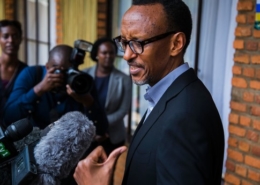Rwanda’s repressive tactics silence dissent before elections
Over the past two decades, smear campaigns, intimidation, disappearances and targeted killings have characterized Rwanda’s political space.
The Rwanda Patriotic Front (RPF) has consolidated its control over Rwanda’s political system, leaving little room for political opposition.Dissenting voices – whether in politics, the media or civil society – have been systematically silenced.
Early on, in the mid to late 90s, political opponents and civil society actors were targeted by smear campaigns, killings and arbitrary arrests. The former President, Pasteur Bizimungu, was prevented from establishing a new political party in 2001. He and his comrade, Charles Ntakirutinka, were later arrested on charges of “inciting civil disobedience” and “association with criminal elements.”
From then on, using the argument of national unity and the fight against “divisionism” and “genocide ideology”, the Rwandan government has continuously restricted civic space.
Rwanda favours “consensus politics” and discourages public criticism and dissent. I am concerned that there is no genuine pluralistic society.
Maina Kiai, former UN Special Rapporteur on Freedom of Association and Assembly

Challengers to the ruling party face systematic legal issues
Pasteur Bizimungu, first post-genocide President, was jailed in 2004 after being convicted on charges of inciting civil disobedience, association with criminals and embezzling state funds. He was released in 2007 after seeking a presidential pardon.
Ahead of the 2003 elections, Faustin Twagiramungu, former Prime Minister, was denied registration of his newly formed party, the Alliance for Democracy, Equity and Progress. His former party, the Democratic Republican Movement (known by its French acronym MDR) was accused of promoting “divisive ideology”. He was forced to interrupt his campaign before the 2003 presidential election, after death threats against his aides.
The 2010 elections were no different. Victoire Ingabire, president of the opposition party United Democratic Forces (FDU-Inkingi) was arrested shortly after she returned from exile in January 2010 on grounds of “terrorism and genocide ideology”. In 2012, she was convicted of “conspiracy to harm existing authorities and constitutional principles by using terrorism and armed violence”. In the Supreme Court’s appeal decision, the judges disregarded her complaints of an unfair trial, upheld previous sentence and found her guilty of “spreading lies to incite the population to revolt.”
No elections without smear campaigns, deaths and disappearances
In May 2017, hours after launching her presidential bid, nude photos of Diane Rwigara, surfaced. Diane Rwigara is the daughter of an influential RPF financier killed in an accident in 2015. She has since complained of intimidation against her representatives, preventing them from campaigning freely.
Illuminée Iragena, a member of the FDU-Inkingi, disappeared on 26 March 2016. To date, the police has been quiet on her case. Leonille Gasengayire was arrested and detained in March 2016 for several days after visiting Victoire Ingabire in prison. She was again arrested in August 2016 on allegations of inciting insurrection but was acquitted and released in March 2017. In May 2017, the body of Jean Damascene Habarugira, a local FDU-Inkingi representative, was found mutilated.
In 2010, just weeks before the elections, the body of André Kagwa Rwisereka, vice president of the Green Party, was found beheaded in Butare. The case remains unresolved.
Some Contenders in the 2017 Elections

Repression in post-genocide Rwanda spanning three election periods to 2017
President Kagame will face two other candidates in the August 2017 polls. The Democratic Green Party leader, Frank Habineza, and an independent candidate, Philippe Mpayimana. After the 2015 constitutional referendum that allowed President Kagame to seek a third term, he is expected to win the upcoming presidential elections in August 2017.
President Kagame’s colleagues in the African Union also expect him to win the upcoming election. On 4 July 2017, the AU Heads of State voted for him to lead the AU from January 2018.
But how did Rwanda get here?
Over the past two decades, Rwanda’s political space and electoral process has been characterized by restrictions on the freedoms of association and assembly, targeted attacks against opposition leaders, killings, disappearances and political trials, weakening civil society and the media. These tactics have had a chilling effect on the social and political scene in Rwanda. Critics self-censor themselves and think twice before expressing their views or challenging those in power.
Please click here to see the full timeline of post-genocide repression in Rwanda.

It is not my job to create opposition parties, but to foster an environment where diverse currents of opinion can express themselves
Paul Kagame
Post-genocide elections in Rwanda
Some key facts and figures about Rwanda elections since 2003


